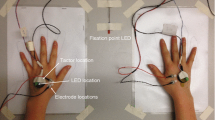Abstract
Laboratory research suggests that the processing of painful stimuli can be modulated by selective attention to a particular sensory modality. However, alternative accounts for previous findings remain possible in terms of task-switching and spatial attention effects. In the present study, we examined whether attention can be selectively directed to the pain modality in order to facilitate the processing of the sensory-discriminative aspects of painful laser heat stimuli when these alternatives were ruled out. Participants made speeded spatial discrimination responses to an unpredictable sequence of painful laser heat and visual stimuli presented on the left forearm. On each trial, a symbolic cue predicted the likely modality for the upcoming target on the majority of trials. Participants responded more rapidly when the target was presented in the expected as opposed to the unexpected modality, demonstrating that selective attention can modulate the processing of painful stimuli. These findings are discussed in relation to contemporary theories of crossmodal attention and multisensory information-processing.
Similar content being viewed by others
Author information
Authors and Affiliations
Corresponding author
Rights and permissions
About this article
Cite this article
Spence, C., Bentley, D.E., Phillips, N. et al. Selective attention to pain: a psychophysical investigation. Exp Brain Res 145, 395–402 (2002). https://doi.org/10.1007/s00221-002-1133-6
Received:
Accepted:
Published:
Issue Date:
DOI: https://doi.org/10.1007/s00221-002-1133-6




